Breaker Size Calculator: A Guide for Engineers in the UAE & GCC
Updated: October 2023
Selecting the correct circuit breaker size is a critical safety and financial decision for any project in the UAE and GCC. An undersized breaker leads to nuisance tripping and costly downtime, while an oversized one creates a significant fire hazard. This guide provides practical, solution-focused insights to ensure your electrical systems are compliant, reliable, and built to withstand the region's demanding climate.
Why Accurate Breaker Sizing is Non-Negotiable in the GCC
In the high-stakes construction and industrial sectors of Dubai, Abu Dhabi, and across the Gulf, precision is paramount. The consequences of miscalculation in electrical protection are not theoretical; they manifest as expensive operational failures and severe safety risks. The unique environmental challenges of the region add another layer of complexity, making a reliable breaker size calculator an essential tool for any professional.
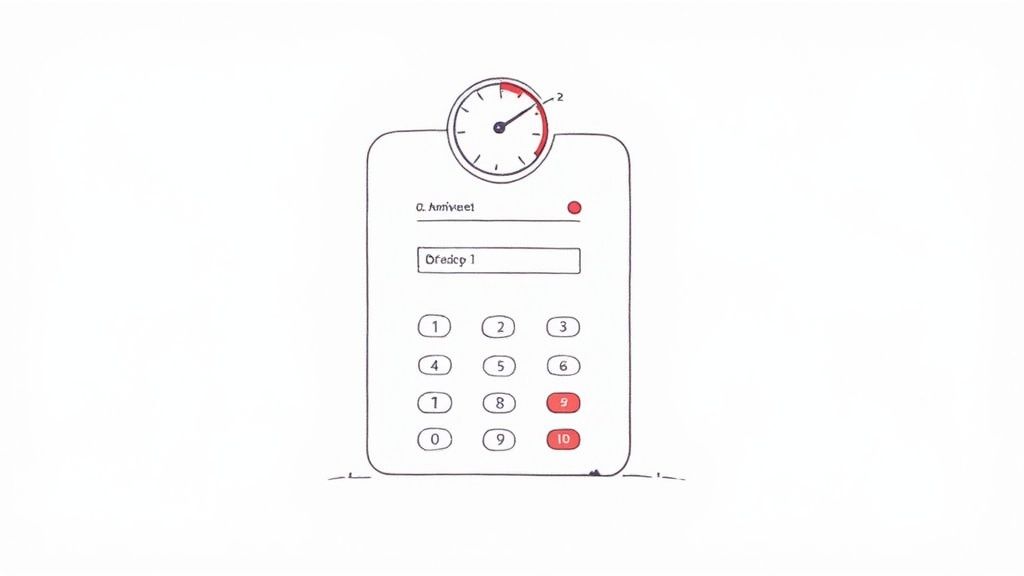
- Climate Challenges: Extreme ambient heat in the UAE and KSA requires careful derating calculations to prevent premature tripping and conductor damage. High humidity can accelerate corrosion, impacting breaker performance, while dust necessitates high IP-rated enclosures to prevent short circuits.
- Regulatory Compliance: Adherence to local utility regulations from bodies like DEWA, ADDC, or SEC is mandatory. Correct sizing is the first step toward passing inspections and ensuring the long-term safety and stability of your installation.
- Asset Protection: In a region with massive infrastructure investments, protecting multimillion-dirham assets is crucial. A simple miscalculation can lead to catastrophic equipment failure and production halts.
The Middle East and Africa (MEA) circuit breaker market, valued at USD 2.11 billion in 2025, is projected to hit USD 3.44 billion by 2032, fueled by projects where robust electrical protection is foundational. You can dive into the market data to understand the scale. A precise calculation translates complex load requirements and harsh environmental factors into a correct specification, safeguarding your project.
Essential Inputs for Your Breaker Calculation
Before using any breaker size calculator, gathering accurate data is non-negotiable. This ensures the output reflects the real-world conditions your equipment will face in the UAE or wider GCC.
| Parameter | Why It's Critical for UAE & GCC Applications |
|---|---|
| Full Load Amps (FLA) | The base current a load draws under normal operation. This is your starting point. |
| Service Voltage | The system voltage (e.g., 400V, 415V). Incorrect voltage invalidates the entire calculation. |
| Phase | Single-phase or three-phase systems have fundamentally different power calculations. |
| Load Type | Motors have high inrush currents requiring special consideration (NEC 430), unlike resistive loads like heaters. |
| Load Duty | Continuous loads (running 3+ hours, common for HVAC in the GCC) require the breaker to be sized at 125% of the load. |
| Ambient Temperature | Crucial for the GCC. High heat demands derating the breaker's capacity per IEC/NEC standards. |
| IP Rating | An enclosure's Ingress Protection (IP) rating is vital to protect against dust and moisture prevalent in the region. |
Gathering Your Core Electrical Load Data
The principle of "garbage in, garbage out" is especially true in electrical design. A minor error in your initial data can lead to major safety and operational issues. For engineers and panel builders working on projects from a Dubai skyscraper to an industrial plant in Saudi Arabia, meticulous data collection is key.
1. Determine Full Load Amperes (FLA)
The FLA is the current a piece of equipment draws at maximum output, typically found on its nameplate. If only power in watts (W) or kilowatts (kW) is provided, you must calculate the FLA based on your system's voltage and phase.
2. Identify Single-Phase vs. Three-Phase Systems
The calculation for current differs significantly between system types.
- Single-Phase: Common in light commercial settings. Power (W) / Voltage (V) = Amps.
- Three-Phase: The standard for industrial machinery and heavy equipment in the GCC. Power (W) / (Voltage × √3 × Power Factor) = Amps.
Expert Tip: For industrial loads like large motors, the power factor (PF) is critical. A low PF increases current draw, directly impacting the required breaker size. Always use the PF from the equipment's datasheet.
3. Apply the 125% Rule for Continuous Loads
A continuous load runs at maximum current for three hours or more—a common scenario for air conditioning and process pumps in the GCC. Safety standards mandate that the circuit breaker and conductors be sized for 125% of the continuous load's FLA.
Practical Example: Sizing for a Water Pump in Abu Dhabi
1. Gather Data from the Nameplate:
- Power: 15 kW (15,000 Watts)
- Voltage: 400V (Three-Phase)
- Power Factor (PF): 0.85
- Duty: Continuous
2. Calculate the FLA:
- Current (Amps) = 15,000 / (400 × 1.732 × 0.85)
- Current ≈ 25.5 Amps (FLA)
3. Apply the 125% Rule:
- Required Breaker Rating = 25.5 Amps × 1.25
- Required Breaker Rating = 31.88 Amps
You would select the next standard breaker size up, such as a 32A or 40A model. The breaker is only half the equation; ensure your conductors are also correctly sized using a dedicated cable size calculator.
Applying Temperature and Conductor Adjustments
After the initial calculation, you must adjust for site-specific conditions. This step is crucial for ensuring system longevity in the Middle East's demanding environment. The relationship between breaker size, wire ampacity, and ambient heat dictates the safety of your installation.
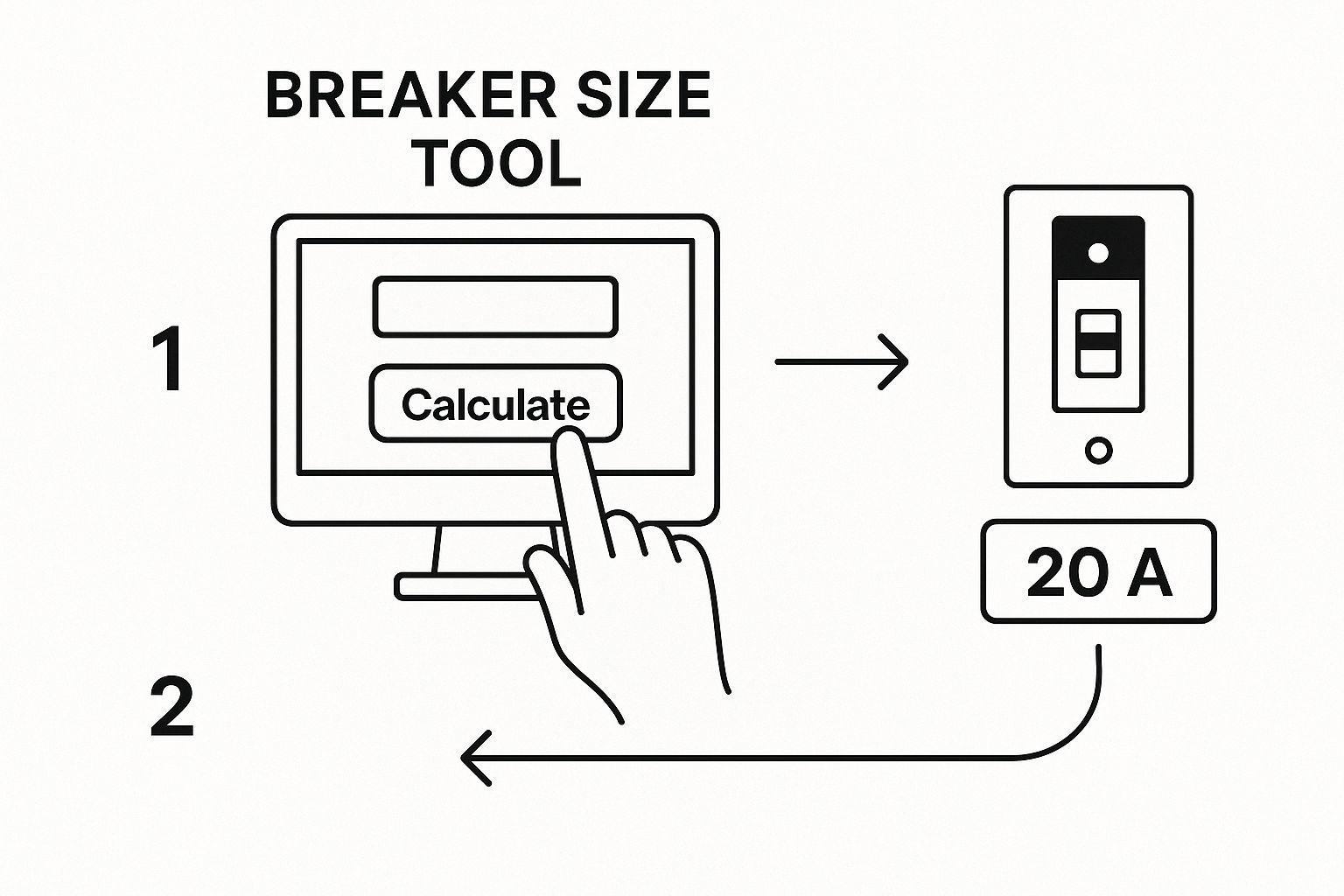
1. Ambient Temperature Derating
For any project in the GCC, temperature correction is non-negotiable. With summer temperatures in Dubai or Riyadh often exceeding 45°C, conductor ampacity must be derated.
- Process: Determine the highest likely ambient temperature for the conductor's location. Using IEC or NEC tables, find the correction factor for your temperature and conductor type. Multiply the conductor's standard ampacity by this factor to find its true, safe capacity.
- Impact: A wire's ampacity can be reduced by 15-20% or more, requiring a larger conductor size to handle the same load safely.
2. Conductor Bundling Correction
When multiple current-carrying conductors run in a single conduit, heat buildup reduces the ampacity of each wire. This effect is cumulative with temperature derating.
| Number of Conductors in a Conduit | Ampacity Adjustment Factor |
|---|---|
| 4–6 | 80% (0.80) |
| 7–9 | 70% (0.70) |
| 10–20 | 50% (0.50) |
| 21–30 | 45% (0.45) |
A wire rated for 30A could be reduced to just 15A if bundled with nine other active conductors. A breaker size calculator that incorporates these derating factors is essential for creating robust and compliant electrical systems. The scale of medium voltage installations across the region makes these precise calculations vital; you can read the full research on regional circuit breaker market trends for more context.
Selecting the Right Breaker After Your Calculation
A calculated amperage is just a number. The engineering skill lies in translating it into a physical, compliant circuit breaker. The cardinal rule, mandated by IEC and NEC standards, is to round up to the next standard breaker size.
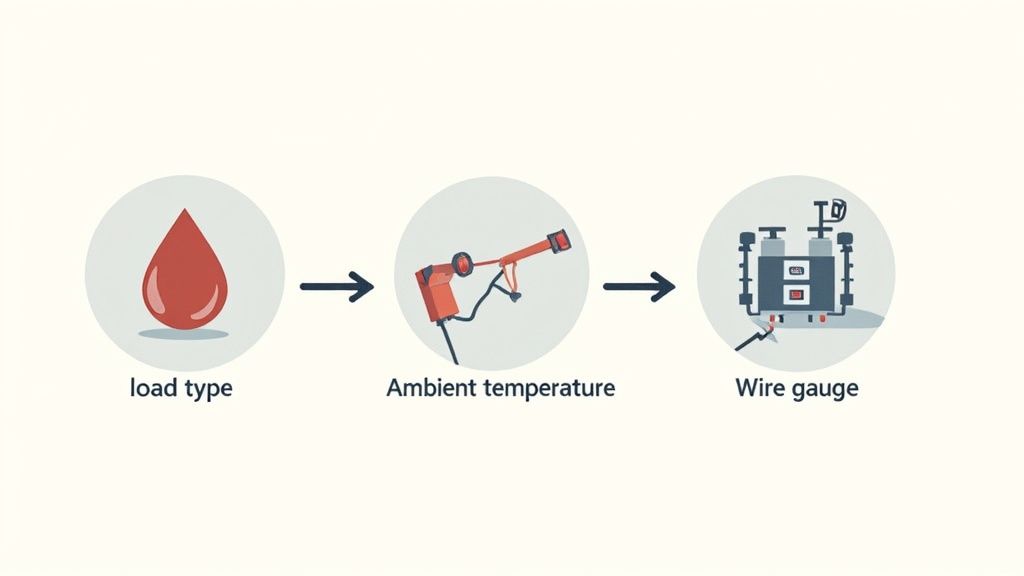
If your calculation yields a required rating of 23A, you must select the next standard size up, typically a 25A or 30A breaker. This ensures the breaker accommodates the operational load without nuisance tripping while still protecting the circuit.
Differentiating Between Breaker Types
Choosing the correct breaker type is as important as its amperage rating.
- MCB (Miniature Circuit Breaker): The standard for final circuits (lighting, sockets) up to 125A. A DIN rail isolator is often used with MCBs for safe maintenance.
- MCCB (Moulded Case Circuit Breaker): Used for higher currents (100A to over 1000A) to protect sub-mains and large motors. They often feature adjustable trip settings for better coordination. Explore our MCCB circuit breaker options for industrial-grade solutions.
- ACB (Air Circuit Breaker): The heavy-duty choice for main power distribution in large facilities, handling currents up to 6300A or more.
Understanding Trip Curves for Precise Protection
A breaker's trip curve determines how it responds to overcurrents, which is critical for preventing both nuisance trips and equipment damage.
Common IEC 60898-1 Trip Curves
| Trip Curve | Instantaneous Trip Range | Primary Application in GCC Projects |
|---|---|---|
| Type B | 3 to 5 times In | Resistive loads (heaters, incandescent lighting). |
| Type C | 5 to 10 times In | General-purpose use; ideal for most commercial socket circuits and lighting with moderate inrush. |
| Type D | 10 to 20 times In | High inrush loads such as large motors, transformers, and industrial machinery. |
Sizing Breakers for Specialized MEA Applications
Many projects in the UAE and KSA involve complex scenarios where a standard breaker size calculator is insufficient.
1. Motor Loads and High Inrush Currents
Large motors in HVAC and industrial systems have high startup currents that can trip standard breakers. A Motor Protection Circuit Breaker (MPCB) is the ideal solution. MPCBs are designed with:
- Adjustable thermal trips to match the motor's specific FLA.
- High magnetic trip thresholds to withstand inrush current.
- Phase-loss sensitivity to protect against unbalanced conditions.
For these applications, GoSwitchgear offers a comprehensive range of electrical protection equipment.
2. DC Breakers for Solar and EV Infrastructure
The rapid growth of solar PV and EV charging stations demands specialized DC circuit breakers. Unlike AC, a DC fault arc is difficult to extinguish. Using a standard AC breaker on a DC circuit is a severe fire hazard. Specialized DC breakers, along with components like an SMPS power supply for control circuits, are essential for these modern energy management solutions in Dubai and the GCC.
3. Selective Coordination in Critical Facilities
In data centers and hospitals, a small fault cannot cause a widespread outage. Selective coordination ensures only the breaker nearest the fault trips. This requires a detailed study of the time-current curves (TCCs) of all breakers in the system to ensure there is no overlap, guaranteeing system resilience.
While this guide covers some specific technical points, it's also crucial for professionals to connect with their clients. For those in the field, exploring effective digital marketing strategies for electrical contractors can be a powerful way to grow your business.
Still Have Questions About Breaker Sizing?
Here are answers to common questions from professionals in the UAE and GCC.
What if the manufacturer’s manual recommends a different size?
Always trust the manufacturer's recommendation (e.g., from Victron or Danfoss) as the baseline. However, if your own calculation, adjusted for GCC ambient heat, suggests a larger size, always default to the more conservative (larger) size. This ensures compliance and reliability in our harsh climate.
Can I use the same size breaker for a motor and a heater with the same FLA?
No. A heater is a resistive load with steady current. A motor is an inductive load with high inrush current. A motor requires a breaker with a Type D trip curve or a dedicated MPCB to avoid nuisance tripping.
Why do I need to round up to the next standard breaker size?
Safety standards require the protective device rating to be equal to or greater than the calculated load. Since breakers come in standard sizes (16A, 20A, 25A), you must select the next available size up to ensure safe operation.
Does a breaker size calculator account for voltage drop?
No, most do not. Voltage drop is a separate but critical calculation, especially for long cable runs common in the GCC. After sizing your breaker, use a tool like our Cable Size Calculator to ensure voltage drop remains within the acceptable 3-5% limit.
Conclusion
Navigating the complexities of circuit protection in the UAE and GCC requires a blend of precise calculation, adherence to local standards, and an understanding of environmental challenges. By carefully gathering data, applying necessary derating factors, and selecting the appropriate breaker type and size, you can design electrical systems that are safe, reliable, and built to last.
For expert project support in Dubai or a quote for your Abu Dhabi project, our team is ready to assist. Trust GoSwitchgear for all your electrical components in the UAE.
Explore our complete catalog and find the components you need at https://goswitchgear.ae.



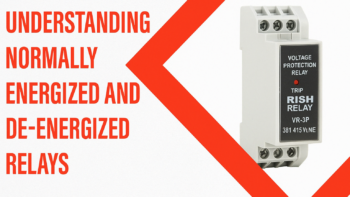




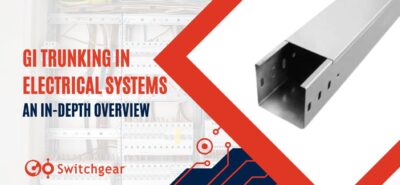

Leave a Reply